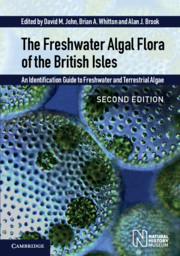 The Freshwater Algal Flora of the British Isles
The Freshwater Algal Flora of the British Isles Book contents
- Frontmatter
- Contents
- The online material (formerly provided in DVD format)
- List of Contributors
- Foreword
- Preface
- Acknowledgements
- Introduction
- Distribution and Ecology
- History of Freshwater Algal Studies in the British Isles
- Field Methods
- Laboratory Methods
- Water Framework Directive
- Cultures of British Freshwater Algae
- Classification
- Key to phyla
- Cyanobacteria (Cyanophyta)
- Phylum Rhodophyta (Red Algae)
- Phylum Euglenophyta (Euglenoids)
- Phylum Cryptophyta (Cryptomonads)
- Phylum Dinophyta (Dinoflagellates)
- Phylum Raphidophyta
- Phylum Haptophyta (Prymnesiophyta)
- Phylum Chrysophyta (Golden Algae)
- Phylum Xanthophyta (Tribophyta) (Yellow-Green Algae)
- Phylum Eustigmatophyta
- Phylum Bacillariophyta (Diatoms)
- Phylum Phaeophyta (Brown Algae)
- Primitive Green Algae (‘PRASINOPHYTA’)
- Phylum Chlorophyta (Green Algae)
- Phylum Glaucophyta
- Glossary
- Standard Form of Authors of Algal Names
- Sources of Illustrations or Material
- References
- Taxonomic Index
- Subject Index
- Plate Saction
- Miscellaneous Endmatter
- Miscellaneous Endmatter
Phylum Haptophyta (Prymnesiophyta)
Published online by Cambridge University Press: 12 January 2024
- Frontmatter
- Contents
- The online material (formerly provided in DVD format)
- List of Contributors
- Foreword
- Preface
- Acknowledgements
- Introduction
- Distribution and Ecology
- History of Freshwater Algal Studies in the British Isles
- Field Methods
- Laboratory Methods
- Water Framework Directive
- Cultures of British Freshwater Algae
- Classification
- Key to phyla
- Cyanobacteria (Cyanophyta)
- Phylum Rhodophyta (Red Algae)
- Phylum Euglenophyta (Euglenoids)
- Phylum Cryptophyta (Cryptomonads)
- Phylum Dinophyta (Dinoflagellates)
- Phylum Raphidophyta
- Phylum Haptophyta (Prymnesiophyta)
- Phylum Chrysophyta (Golden Algae)
- Phylum Xanthophyta (Tribophyta) (Yellow-Green Algae)
- Phylum Eustigmatophyta
- Phylum Bacillariophyta (Diatoms)
- Phylum Phaeophyta (Brown Algae)
- Primitive Green Algae (‘PRASINOPHYTA’)
- Phylum Chlorophyta (Green Algae)
- Phylum Glaucophyta
- Glossary
- Standard Form of Authors of Algal Names
- Sources of Illustrations or Material
- References
- Taxonomic Index
- Subject Index
- Plate Saction
- Miscellaneous Endmatter
- Miscellaneous Endmatter
Summary
Most species of Haptophyta (also known as Prymnesiophyta) are single-celled flagellates, but some may have amoeboid, coccoid, palmelloid or filamentous stages. The flagellate cells have usually two flagella of equal or subequal length (unequal in the order Pavlovales), both of which are smooth. In most members of the Pavlovales the forward one is covered with small knob-like scales and fine non-tubular hairs that are invisible in the light microscope; tubular flagellar hairs as in the Chrysophyta or other heterokont flagellates do not exist in the Haptophyta. The two flagella may have a similar action (homodynamic) or move differently (heterodynamic). Between them there is a characteristic additional appendage, the haptonema. Depending on the species, this organelle is long, thread-like, exceeding the cell in length, or shorter, bulbous, or vestigial. It consists of 6 or 7 microtubules enclosed in two or three sheathing membranes (not visible with light microscopy). Haptonemata are capable of bending and flickering and, if long, can coil rapidly and uncoil slowly in response to shock. Haptonemata do not play a role in locomotion, but may be used in prey capture or anchoring the cell. The 1–2(–4) chloroplasts are usually golden or yellow-brown, because accessory photosynthetic pigments mask the green of the chlorophyll (chlorophylls a, c1/c2 and sometimes c3). The surface of the cell is covered with minute scales or granules of organic composition (not visible in light microscope) and, in addition, there may be calcified scales (coccoliths) visible in the light microscope; species with such scales are called coccolithophorids.
The Haptophyta comprises at present some 80 genera and 300 species; a large number of additional genera and species of fossil coccolithophorids have been described. Especially common in marine waters are species of Chrysochromulina, Phaeocystis and coccolithophorids (e.g. Emiliania huxleyi). Only about a dozen haptophyte species are known from freshwater or terrestrial habitats. Five have been recorded from the British Isles.
- Type
- Chapter
- Information
- The Freshwater Algal Flora of the British IslesAn Identification Guide to Freshwater and Terrestrial Algae, pp. 277 - 280Publisher: Cambridge University PressPrint publication year: 2021


